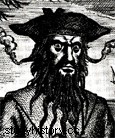Blackbeard

Blackbeard (circa 1680 – November 22, 1718), also known as the name of Edward Teach, Edward Thatch, Tash or Tach and Edward Drummond (supposedly his real name and that given to him by Daniel Defoe) was an English pirate who reigned by terror in the Caribbean from 1716 to 1718.
Blackbeard used to carry, in battle or not, several swords, knives and pistols. He was also known for his skill in sewing hemp and he used, before assaults, to light wicks of gunpowder in his abundant black beard, which earned him his nickname. However, this habit is met with skepticism by some historians. Indeed, it is possible that this image of "pirate with the beard of flames" is only one of the many exaggerations due to the very particular notoriety of the character. Another version would be that he hid barrel locks under his hat and tied the braids of his beard with them.
Life and adventures
The early life of Blackbeard is not well known. He was born in 1680 in Bristol, England. His maritime career began on a privateer patrolling the waters near Jamaica during the War of the Spanish Succession (1701 - 1714). In 1716, he met the pirate Benjamin Hornigold in New Providence and joined his crew. He became a captain while in the service of Hornigold on November 28, 1717:they captured La Concorde, a French ship coming from Nantes and transporting slaves, near Martinique. According to the governor of the island, Edward Teach was in command of two British pirate ships, one armed with eight guns, the other with twelve, and carrying a total of 250 men. The Concorde is a real treasure:a 300-ton frigate armed with 40 guns, which had criss-crossed the African coasts and captured many British, Dutch and Portuguese ships. Blackbeard gives it the name Queen Anne's Revenge.
They plundered six other ships in 1717, on the American coast and in the Caribbean. Towards the end of the year, they capture a French ship loaded with gold, precious stones and other riches, after which the two pirates go their separate ways:Blackbeard heads for America while Benjamin Hornigold returns to New Providence.
Over the next two years, Blackbeard forged a solid reputation as a reckless and cruel pirate by regularly attacking naval and coastal installations in the West Indies and the Atlantic coast of North America. This notoriety is reinforced when he emerges victorious from a duel against the Scarborough, a warship of the crown of Great Britain armed with 30 cannons.
He continues to attack merchant ships, forcing them to let his men board the ship and tranship all wealth, liquor, and arms. If the crew offers no resistance, Blackbeard lets the ship sail away and continue on its way. Otherwise, they are all killed.
Blackbeard sets up several headquarters in the Bahamas as well as in North Carolina and South Carolina. He lives mainly on the island of New Providence where he is often called Magistrate of the Republic of Corsairs. The Governor of North Carolina, Charles Eden, regularly received shares of the spoils in exchange for unofficial protection and later a royal pardon. Blackbeard will then be forced to leave New Providence when Governor Woodes Rogers launches the pirate hunt.
Blackbeard returns to piracy a few weeks later. In 1718, he blocked the port of Charleston. He captures the son of Woodes Rogers and demands a ransom:freedom against drugs. Faced with the increase in the number of his attacks, Charles Eden loses patience and sends troops in pursuit. Blackbeard is cornered by the Pearl, a British Crown warship captained by Robert Maynard, off the coast of Ocracoke. He received more than 25 wounds, including 5 by bullets during a fight that became famous before dying and being beheaded by Maynard. His head will be placed as a trophy on the bowsprit of the Pearl. A legend has it that his body, after being thrown into the sea, swam around the boat twice before sinking.
